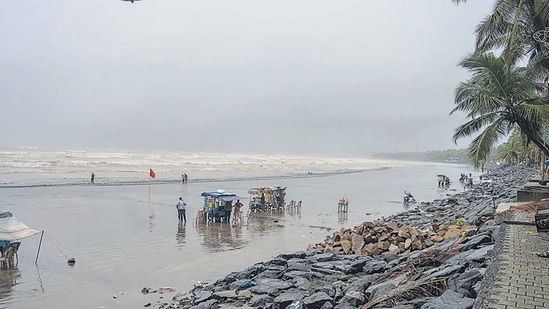Backflow, regular cleaning keep Gorai, Manori beaches tidy
Having taken a hit in their popularity after the closure of the amusement park Essel World, the beaches nonetheless retain their crowds on the weekend
MUMBAI: A ferry away from the Borivali mainland lie the adjacent beaches of Gorai and Manori: the former an idyllic resort spot, the other a more rundown, downmarket version of the first. Having taken a hit in their popularity after the closure of the amusement park Essel World, the beaches nonetheless retain their crowds on the weekend as well as cater to the resident East Indian and Koli population.

Gorai has a natural advantage. “The backflow of water from the sea that reaches Gorai Beach doesn’t carry much garbage with it,” said a civic official from the solid waste management (SWM) department of the BMC’s R Central ward. “So it doesn’t get very dirty.”
Subhas Nishad, a food stall owner who’s plied his trade for 32 years on the beach, agreed. “Gorai is always clean and has been the same for all these years,” he said. “The high tide doesn’t bring too much trash, and what it does gets cleaned by the BMC. People don’t even litter much, using the dustbins we place by the stalls. Compared to all the other beaches in Mumbai, this is naturally the cleanest.”
Nishad spoke of the dwindling number of visitors to the beach, impacting the illegal stalls’ business. “People would come in throngs 20 years ago when Essel World and Water Kingdom opened up,” he said. “The beach would be full by 11 am on weekends, and on weekdays schools would get kids in 50 to 100 buses. We weren’t able to keep up with the demand. After Essel World shut in 2022, there is none of that. Now on weekdays we can just about make ends meet. The crowds go up to 5,000 on the weekends and more on holidays.”
An official from Ram Engineers and Constructions, appointed by the BMC to carry out the cleaning, agreed that Gorai was generally cleaner but added that the sea was unpredictable during the rains. “Sometimes the high tide does bring with it a massive load of garbage—plastic, clothes and wood pieces,” he said. “When it does, we double our manpower and get to it. But it is rare here on Gorai.”
The BMC’s contract for the cleaning of the twin beaches is ₹9,96,14,899 for six years; beginning in March 2021, it will last till 2027. The contracted company brings with it machines—a beach-cleaning machine that combs through the sand and filters out the waste, a skid steer loader that lifts it and a compactor among others. While manpower strength is not specified, around 15 to 20 persons are used daily unless the quantum of waste calls for more.
While the contractor claimed that both machines and manpower were used, others reported a more robust use of the manpower, with workers picking up the trash by hand. “Well, machines are not totally suited to Gorai and Manori, especially Gorai, since the beaches disappear entirely under the high tide, and the sand gets wet more often,” said the BMC official. “There are also rocky portions, where machines can’t be used.”
The waste collection in the dry season goes up to 2 metric tonnes (MT), rising to 2.5 MT in the wet months. The lack of a significant difference, as seen in other beaches where the quantum doubles in the monsoon, is because some of the waste gets buried under the sand in the rains and then gets picked up throughout the year.
Manori Beach comparatively gets the short end of the stick, with more garbage and a less robust cleaning routine according to some locals. “Manori is not frequented by tourists at all,” said the BMC official. “It is mainly used by the kolis, fisherfolk and the East Indian community that lives there. There are also slums next to it so people don’t really go there.” This time however, he added, less plastic was found on the beach than in previous years.
While the contractor agreed that Manori received more waste than Gorai, particularly in the monsoon, he insisted that it was cleaned in the same way. Sharon Kini, an East Indian woman and indigenous farmer in the area, however begged to differ. “The Manori side does not get cleaned properly,” she said. “The BMC’s contractor only cleans it when we call and complain, and even then only cleans a portion. The far end, which is populated by the kolis, is even dirtier.”
Another local Joseph Buckman, who jogs on the stretch every morning, had a different opinion. “The high tide does get a lot of waste in during the monsoon but the BMC’s contractor cleans it right up,” he said. “Even the kolis, who generate waste when they clean their catch, dispose of it. The beach stays clean except for the time when the high tide has just spat garbage on it.”
Stay updated with all the Breaking News and Latest News from Mumbai. Click here for comprehensive coverage of top Cities including Bengaluru, Delhi, Hyderabad, and more across India along with Stay informed on the latest happenings in World News.
Stay updated with all the Breaking News and Latest News from Mumbai. Click here for comprehensive coverage of top Cities including Bengaluru, Delhi, Hyderabad, and more across India along with Stay informed on the latest happenings in World News.






